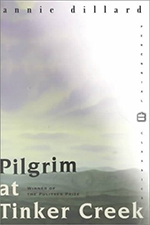While my son takes banjo lessons downtown , I stroll Charlottesville’s walking mall and browse the bookstores. Last week, I dropped $40 at one of the used-book stores, walking away with an armful of volumes. Most were intended for my son (a voracious reader in addition to being banjo-philic), but on the shelf I also saw a trade paperback copy of Pilgrim at Tinker Creek, by Annie Dillard (1974), a book without which I think no naturalist’s library in Virginia is complete. I’ve read it before, but I love it dearly — so I bought it.
, I stroll Charlottesville’s walking mall and browse the bookstores. Last week, I dropped $40 at one of the used-book stores, walking away with an armful of volumes. Most were intended for my son (a voracious reader in addition to being banjo-philic), but on the shelf I also saw a trade paperback copy of Pilgrim at Tinker Creek, by Annie Dillard (1974), a book without which I think no naturalist’s library in Virginia is complete. I’ve read it before, but I love it dearly — so I bought it.
Winner of the Pulitzer Prize for general nonfiction in 1975, Pilgrim is a work of wonder at nature and the fact of our existence. Like no other book I’m aware of, it captures the giddiness of the transcendent experience. Dillard has a talent for putting herself in natural settings and being receptive to whatever is offered up. “I cannot cause light,” she writes. “The most I can do is try to put myself in the path of its beam.” Where that beam shines, it illuminates, and by forming shadows it its absence, the light causes her myriad subjects to pop into relief. Once lit, a landscape or organism is seen in a new way. It means something different by virtue of Dillard’s eye catching those reflections and refractions, by virtue of the way those photons stimulate her mind.
Her language is equally adept at describing the natural world in her Roanoke Valley home and describing her own personal reactions to being out there, receptive to nature’s clockwork and chaos. I think that, at least in this one book, she achieves the most resonant articulation of what it is to be astonished by one’s experiences perceiving natural phenomena. “I had been my whole life a bell, and never knew it until at that moment I was lifted and struck.” It’s a beautiful book that drifts in and out of what you might call ‘nature writing’ and what you might call poetry. There is a substantial infusion of Biblical analogy and mythology, which isn’t my cup of tea, but does frame Dillard’s perspective as distinctive. Her evocations of God serve to emphasize the intense profundity of her experience, and I can relate to that, even if my own experiences lack the spice of belief.
This is my fourth time reading Pilgrim at Tinker Creek, and it still gives me a frisson of astonishment when I read it. It is such a good book.

Lovely review, Callan–
Carmen Grayson
Voices from the past–yours and Annie’s! I’ve wondered about you and what you’re doing and then you pop up with a beautiful review of Pilgrim at Tinker Creek. I read the book around 1977 and was just as enthralled as you make it sound. She made me feel a kindred spirit. I think of it now and then and now I know I have to read it one more time. Thank you!